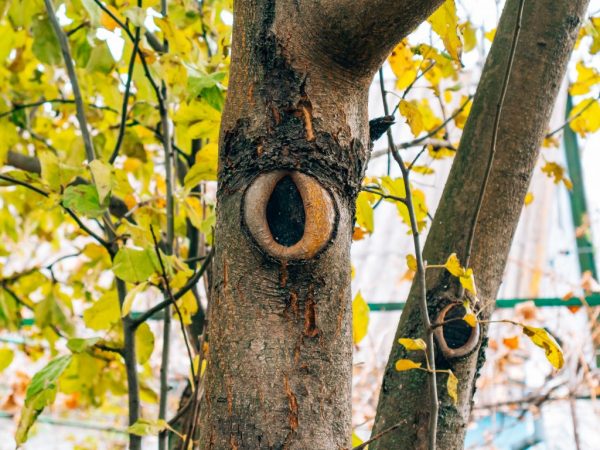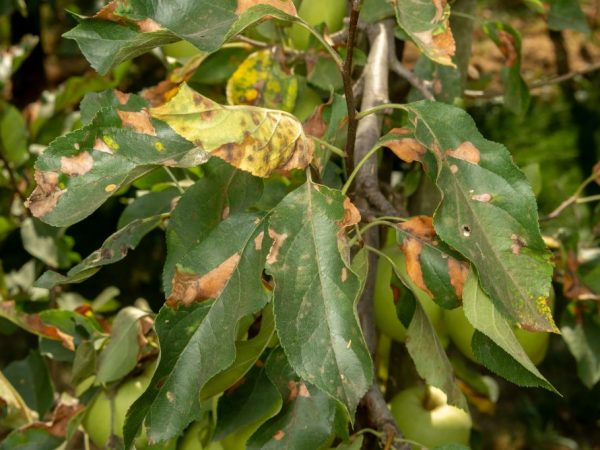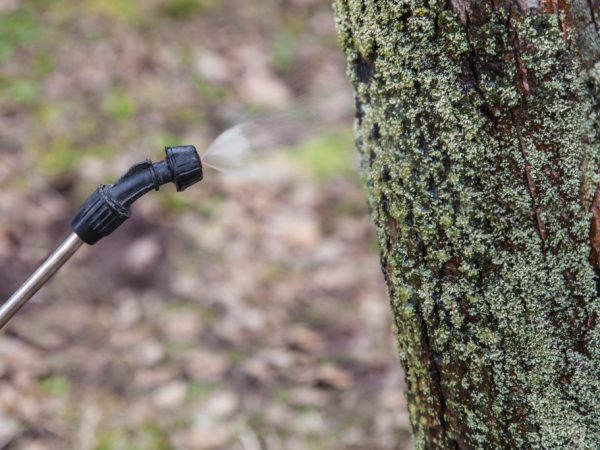Fighting fungus on an apple tree
The fungus on the apple tree retains its vital activity for a long time and is able to activate when conditions favorable for it appear. With the appearance of a fungus in a garden crop, immunity to diseases decreases and, as a result, the yield level becomes lower, and sometimes this leads to the death of trees.
- Varieties of fungus
- Sooty
- White
- Lichens
- Red
- The black
- The causes of the appearance of fungi
- What and how the fungus is treated
- Foliage and branch processing
- Trunk and bark treatment
- Root treatment
- Fruit processing
- Preventive measures against fungus
- Pruning
- Pest control
- Chemical treatment
- Top dressing
- Preparing the garden for winter
- Conclusion

Fighting fungus on an apple tree
Varieties of fungus
Each variety has distinctive features, but they are all similar to the description of the symptoms of an external manifestation:
- the lesion focus appears as a separately taken oily translucent or velvety spot (plaque), it can be of different colors - red, gray, white, yellowish;
- leaves turn yellow, curl and dry out;
- the fruits are covered with specks, which grow in size over time, the fruit surface rots or stiffens, becoming covered with cracks, apples are mummified, fall off.
Several types of fungi are found on apple trees.
Sooty
The sooty fungus settles on the bark of the apple tree, branches, foliage and fruits, forming a black bloom. Its main nutrition is plant sap flowing from cracks in the bark. It also feeds on sweet secretions formed during the life of harmful insects.
Damaged leaves dry out and fall off prematurely. Apples become covered with black specks, losing their presentation and shortening their shelf life.
White
Initially, white fungus spores appear on apple foliage as a powder. Over time, the plaque darkens and becomes brown. The foliage turns yellow, the branches dry out, the apples are not tied.
Lichens
Lichen mushrooms are not dangerous for horticultural culture. Having no roots, they do not feed on the plant sap of trees and do not weaken their vitality.
However, their appearance on the bark is a sign that the apple tree is losing strength for other reasons, which are often pests and pathogens of various etiologies.
Red
It manifests itself in the form of foci of a reddish-brown hue. Under its action, the bark dies off, in its place a small tuberosity forms with a shield or plastic of white, black or gray color, formed by thin mushroom filaments.
The black
The appearance of black fungus is the primary sign of cancer. In most cases, it is not possible to save the apple tree, after 3-5 years it dies.
The causes of the appearance of fungi

High humidity can cause disease
The defeat of the apple orchard occurs with pathogenic fungi, the spores of which winter in fallen leaves, apples and cracks in the tree bark. They are activated when favorable conditions come for them:
- simultaneous increase in air temperature and an increase in humidity;
- mechanical damage to tree bark, not treated with garden varnish or other antiseptic;
- regular accumulation of condensation on the bark due to inadequate pruning of the crown and lack of proper circulation of air flows.
Overwintered myceliums in warm weather begin active reproduction and cover healthy parts of trees.
The following are often associated with the appearance and development of fungal diseases on an apple tree:
- ignoring preventive treatments for horticultural crops in the spring until the buds swell and after they open;
- preference for tree irrigation by sprinkling;
- leaving plant residues in the fall when preparing the garden for winter;
- no whitewash on boles.
What and how the fungus is treated
Treatment is carried out after identification of the pathogen. However, many gardeners, in all cases of manifestation of signs of a fungal infection, prefer to immediately start treating with pesticides. The use of chemicals is a reliable way to save the garden culture.
Young apple trees with high immunity are less susceptible to infection.
Commonly used tools include:
- Bordeaux liquid;
- HOM;
- Speed;
- Topaz, etc.
Foliage and branch processing
In case of leaf fungus infection, treatment is reduced to spraying. In this case, treatment procedures are carried out depending on the vegetative stage:
- until the blossoming of apple buds - vitriol in a solution with a concentration of 3%;
- during the flowering period, they use biological compounds - Fitosporin, Integral, Mikosan;
- after the end of the budding stage - vitriol in a solution with a concentration of 1%;
- at the stage of apple ripening - baking soda in a solution with a concentration of 1.5-2%;
- at any time of the growing season - with caustic soda in a solution with a concentration of 1%.
When all the fruits are harvested, the branches can be sprayed with a pesticide (you can use, for example, Skor).
Severely affected branches are not treated, but pruned.
Trunk and bark treatment
If lesions are found on the tree bark of the trunk, the areas damaged by the fungus are pre-cleaned and washed with disinfectant solutions:
- copper or iron sulfate with a concentration of 5%;
- caustic soda (100 g per 10 liters of water).

Infected areas must be washed
2 weeks before harvesting, the affected areas of the apple tree trunk can be treated with vitriol with a concentration of 1% with the addition of soap or baking soda (150 g per 10 l of water).
Root treatment
Treatment of the root system affected by the fungus is carried out similarly to the treatment of the trunk with preliminary cleaning of the damaged areas and subsequent treatment with disinfectant solutions with vitriol and caustic soda.
Fruit processing
At the fruiting stage, processing of affected apples is carried out using biological preparations - Planriz, Fitosporin, Gamair and the like.
Adult trees at the stage of ovary formation or during the ripening of fruits are treated with baking soda in a solution (150 grams per 10 liters of water). At the same time, at the stage of ovaries, the apple tree in most cases, after processing, discards the inflorescences, thereby remaining subsequently without fruit.
However, the loss of yield is compensated by the horticultural crop saved from the fungus, which, with proper subsequent care, will bear fruit again for the next season.
Preventive measures against fungus
Preventive measures against fungal pathogens require high-quality maintenance of the horticultural crop.
Pruning
The best measure to prevent the appearance and development of fungus is regular pruning of trees, allowing air currents to move freely inside the crown.
- In the spring, the branches are cut until the buds swell. This allows you to create additional protection against pests, all new wounds must be lubricated with garden varnish, which prevents infections and fungal spores from penetrating through them;
- In autumn, as a preventive measure for the settlement of mushroom spores, which remain for the winter, trees rejuvenate. To do this, the crown is thinned as much as possible and protected by whitewashing their boles.
Pest control
Insect pests contribute to the spread of fungal diseases, therefore, traps are set in the apple orchard, and also attract their natural enemies - birds and beneficial insects.
Chemical treatment
At the same time, prophylactic spraying with Bordeaux liquid with a concentration of 3% or other means of complex action allows you to effectively combat the appearance of fungus and pests. At the same time, it is recommended to process the trunk circles.
The soil is disinfected with urea with a concentration of 7% or ammonium nitrate with a concentration of 10%. After carrying out the disinfecting treatment, after 2-3 days, the soil is dug up.
Top dressing
Regular feeding increases the immunity of apple trees and helps them fight against the appearance of fungus. In autumn, the tree is fed with fertilizer complexes containing phosphorus and potassium.
Preparing the garden for winter
When preparing an apple orchard for winter, they try to get rid of all remnants of vegetation, which can serve as a place for the preservation of fungal spores. Fallen leaves are burned. Rotten apples are not left on the branches, especially those mummified as a result of infection.
Conclusion
Fungal infections of apple trees significantly weaken the garden culture and reduce yield indicators. In some cases, for example, with black crayfish, they lead to the death of trees.
Fungal diseases are often treated with pesticides, which allow eliminating the pathogen in the early stages and preserving the future harvest and the apple trees themselves.
Preventive measures involve adherence to basic rules in the process of caring for horticultural crops.


